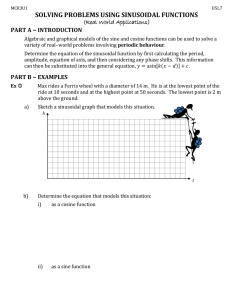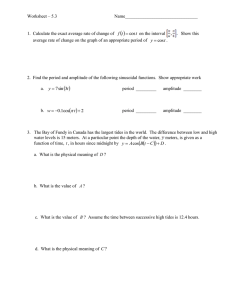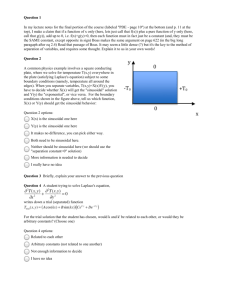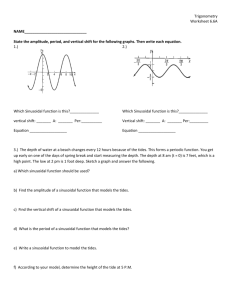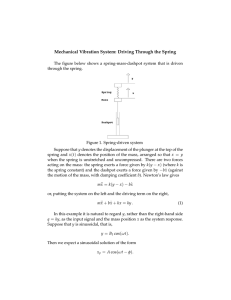Teacher Notes PDF - Texas Instruments
advertisement
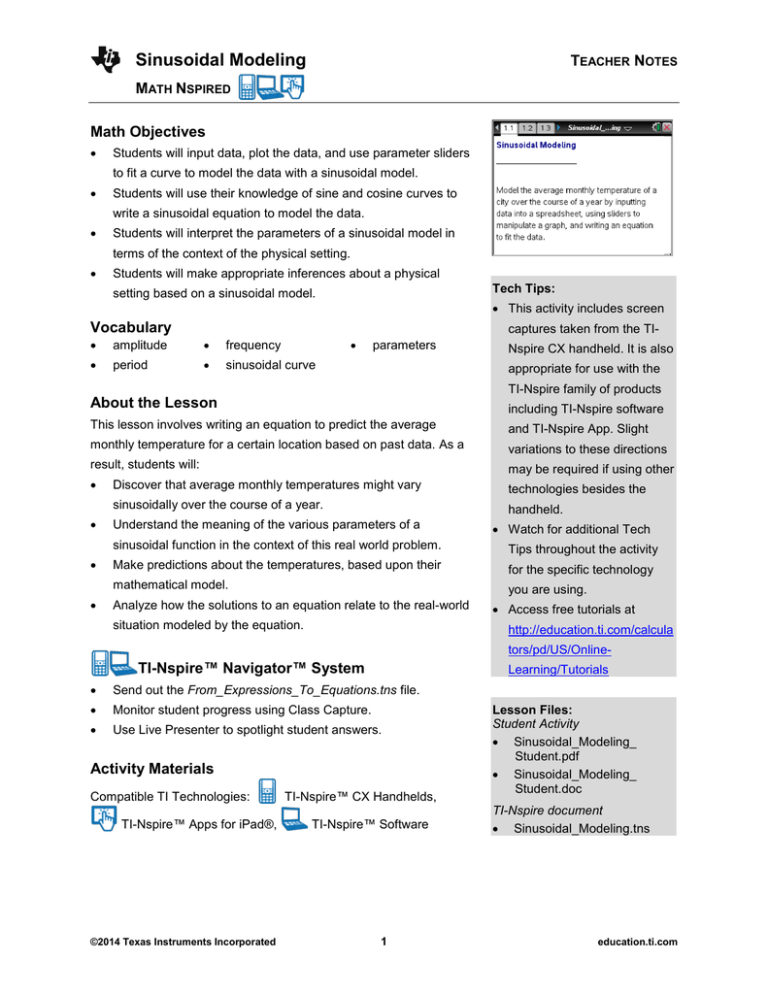
Sinusoidal Modeling TEACHER NOTES MATH NSPIRED Math Objectives Students will input data, plot the data, and use parameter sliders to fit a curve to model the data with a sinusoidal model. Students will use their knowledge of sine and cosine curves to write a sinusoidal equation to model the data. Students will interpret the parameters of a sinusoidal model in terms of the context of the physical setting. Students will make appropriate inferences about a physical Tech Tips: setting based on a sinusoidal model. This activity includes screen Vocabulary amplitude period captures taken from the TI- • • • frequency parameters sinusoidal curve Nspire CX handheld. It is also appropriate for use with the TI-Nspire family of products About the Lesson including TI-Nspire software This lesson involves writing an equation to predict the average and TI-Nspire App. Slight monthly temperature for a certain location based on past data. As a variations to these directions result, students will: may be required if using other Discover that average monthly temperatures might vary technologies besides the sinusoidally over the course of a year. handheld. Understand the meaning of the various parameters of a Watch for additional Tech sinusoidal function in the context of this real world problem. Tips throughout the activity Make predictions about the temperatures, based upon their for the specific technology mathematical model. you are using. Analyze how the solutions to an equation relate to the real-world situation modeled by the equation. Access free tutorials at http://education.ti.com/calcula tors/pd/US/Online- TI-Nspire™ Navigator™ System Learning/Tutorials Send out the From_Expressions_To_Equations.tns file. Monitor student progress using Class Capture. Use Live Presenter to spotlight student answers. Activity Materials Compatible TI Technologies: TI-Nspire™ Apps for iPad®, ©2014 Texas Instruments Incorporated TI-Nspire™ CX Handhelds, TI-Nspire™ Software 1 Lesson Files: Student Activity Sinusoidal_Modeling_ Student.pdf Sinusoidal_Modeling_ Student.doc TI-Nspire document Sinusoidal_Modeling.tns education.ti.com Sinusoidal Modeling TEACHER NOTES MATH NSPIRED Discussion Points and Possible Answers Teacher Tip: You can use the temperature data provided in the table at the end of these Teacher Notes, or have students research and use their own data. Students can all use the same data, or work individually or in groups and each use different data. Information for this experiment was taken from: http://www.erh.noaa.gov/okx/climate/records/monthannualtemp.html. This website gives the average temperature in Central Park, New York from 1869 to the present year. Another good source for data is http://www.worldclimate.com/. This website contains over 85,000 records of world climate data (historical weather averages) from a wide range of sources. 1. You will be modeling the average monthly temperature of a city over the course of a year. Your teacher will explain how you will obtain the data for this activity. a. What city have you chosen? Sample Answer: Students answers will vary, depending upon the city they are using. The Sample Answers given for this activity are based on the average monthly temperatures at Central Park in New York, NY. This information was taken from the spreadsheet provided at the end of these Teacher Notes. b. For what year(s) was your data gathered? Sample Answer: The temperatures used for the answer key are the means of the average monthly temperatures in Central Park, New York for the time period 1977–2010. (This information was taken from the table given at the end of this activity.) ©2014 Texas Instruments Incorporated 2 education.ti.com Sinusoidal Modeling TEACHER NOTES MATH NSPIRED TI-Nspire Navigator Opportunity: Quick Poll See Note 1 at the end of this lesson. Move to page 1.2. 2. Enter your data into the spreadsheet on this page, using t = 1 to represent the month of January. a. What is the highest temperature in your list? o Sample Answer: The highest temperature is 77 . Teacher Tip: The data used for the Sample Answers provided for this activity is as follows: Month Ave. Temp. 1 32.6 2 34.9 3 42.9 4 53.4 5 63 6 71.7 7 77 8 75.9 9 68.4 10 57.1 11 48.1 12 37.8 b. What is the lowest temperature in your list? o Sample Answer: The lowest temperature is 32.6 . TI-Nspire Navigator Opportunity: Class Capture and Live Presenter See Note 2 at the end of this lesson. ©2014 Texas Instruments Incorporated 3 education.ti.com Sinusoidal Modeling TEACHER NOTES MATH NSPIRED Move to page 1.3. 3. A scatter plot of your data will be generated automatically on Page 1.3. What type of function do you think could be used to model this data? Why does this make sense? Sample Answer: A sinusoidal function seems like a good model. The temperature appears to increase then decrease over the year, and we expect this temperature pattern to repeat every year. It looks as if an "upside down" cosine curve would fit the data well. Teacher Tip: Some students might want to fit the data with a polynomial function. You might want to stop at this point to have a discussion about why a sinusoidal function is better than a polynomial function in this problem. Move to page 1.4. 4. In addition to the scatter plot, the graph of the function y a cos(b ( x c )) d has been added to this page. Answer the following questions, and then manipulate the sliders to fit a curve to the data. a. How high will your graph go? How low? o o Sample Answer: My graph should go up to 77 and down to 32.6 . Tech Tip: With sliders, you can use e and the arrows to easily change the value. Also you can click on the value and type in the number. Tech Tip: Tap on the arrows to change the values of the slider. b. Assuming a > 0, do you expect there will be a negative sign preceding a? Why or why not? Sample Answer: Since the function y cos( x ) starts at its maximum value, and our function starts at its minimum value, there will be a negative sign preceding a. ©2014 Texas Instruments Incorporated 4 education.ti.com Sinusoidal Modeling TEACHER NOTES MATH NSPIRED c. Starting with the graph of y cos( x ), will you have to stretch or compress your curve to fit the data? If so, how many months are needed to complete one cosine curve? Sample Answer: Depending upon where the slider is set, we will have to either stretch or compress the curve. If we start with the basic cosine function, y cos( x ), we will have to stretch it. Since it takes 12 months to complete one cycle of the curve. the period of our curve is 12, while the period of the curve y cos( x ) is only 2, a little more than 6. d. Starting with the graph of y cos( x ), will you have to move your function vertically? If so, what vertical shift is needed? Sample Answer: Depending upon where the slider is set, we might have to shift the function up or down vertically. If we start with the basic cosine function, y cos( x ), we will have to move the function up. The midline of our curve is half-way between 32.6 and 77, while the midline of the curve y cos( x ) is y = 0. e. Starting with the graph of y cos( x ), will you have to move your function horizontally? If so, what horizontal shift is needed? Sample Answer: Depending on where the slider is set, we might have to shift horizontally. If we start with the basic cosine function, y cos( x ), we will have to move the function one unit to the right . since the lowest temperature occurs in January when t = 1. Thus, we must set c = 1 to shift the graph one unit to the right. f. Write the equation you have obtained to fit the data. Sample Answer: An equation that seems to fit the data is y 21cos 0.5 x 1 56. 5. Utilizing your spreadsheet from Page 1.2 of the .tns document, or your scatter plot from Page 1.3, determine the following information: Sample Answer: Highest Temperature Lowest Temperature Midline Amplitude Period Frequency Horizontal Shift ©2014 Texas Instruments Incorporated 5 77 32.6 54.8 22.2 12 /6 1 education.ti.com Sinusoidal Modeling TEACHER NOTES MATH NSPIRED 6. Use the information from the table above to write an equation in the form y a cos(b ( x c )) d to fit the data. a. Write the equation that you obtained, and enter it onto Page 1.4 as f2(x). Sample Answer: By looking at the information from the table above and looking at the scatter plot, we set a = –22.2, b = /6, c = 1, d = 54.8. Thus, our equation is y 22.2cos x 1 54.8. 6 b. How does this equation compare to the one you obtained in question #4? Sample Answer: This equation is similar to the one we obtained in question #4. Although we can't tell by just looking at the curve, it does seem to fit the data slightly better. 7. What is the practical significance of these: a. amplitude? Sample Answer: The amplitude is the difference between the highest (or lowest) monthly temperature and the mean monthly temperature (which is the midline of the graph). The amplitude essentially tells us how much the highest and lowest average monthly temperatures vary from the mean monthly temperature. b. midline? Sample Answer: The midline is the horizontal line in the middle of the graph of the function. It is the mean of the highest and lowest monthly temperatures. c. period? Sample Answer: The period tells us how long it takes to complete one cycle. Since this data gives us the average monthly temperatures over the course of a year, one cycle is twelve months. d. horizontal shift? Sample Answer: The horizontal shift is how far the basic cosine curve has to be shifted to start at the lowest data point. (For other data sets, the cosine curve might start at the highest point.) For our function, the horizontal shift is one unit to the right because January was the coldest month of the year (giving us the minimum value of the function), and t = 1 represents the month of January. ©2014 Texas Instruments Incorporated 6 education.ti.com Sinusoidal Modeling TEACHER NOTES MATH NSPIRED 8. Based on the equation that you wrote for question #6, during what month(s) would the average monthly temperature be 65°? Sample Answer: o To determine when the average monthly temperature would be 65 , we take our equation, set it equal to 65, and solve for x. Thus, we solve 65 22.2cos x 1 54.8. 6 Although this equation can be solved algebraically, it is a bit tedious to do so. We can graph f3(x) = 65, and find the intersection of the two graphs, f2(x) and f3(x). We see that the graphs intersect at x = 4.91 and x = 9.09. Thus, the average monthly temperature is approximately 65° in May (when x = 5) and September (when x = 9). Tech Tip: To find the intersection points graphically when you have only two functions graphed, press MENU > Analyze Graph > Intersection. Select the lower and upper bounds. Tech Tip: To find the intersection points graphically when there are only two function graphed, select > Analyze Graph > Intersection.. Select the lower and upper bounds. Note that in some cases, a student may need to back-out to the main Tools Menu to see the desired menu option. Teacher Tip: If students have chosen their own cities, the temperature in o their chosen city might not ever reach 65 . This question allows a discussion concerning how to estimate the maximum and minimum values of a function by examining its graph. (See question #13 for another example of obtaining maximum and minimum values by examining the equation of a function.) 9. Based on the equation that you wrote for question #6, what would the average temperature be in February? Sample Answer: To determine what the average monthly temperature would be in February, we find f(2). Substituting x = 2, we get f (2) 22.2cos 2 1 54.8 35.5742. Based upon our 6 equation, the average temperature in February is approximately 35.6°. ©2014 Texas Instruments Incorporated 7 education.ti.com Sinusoidal Modeling TEACHER NOTES MATH NSPIRED Tech Tip: To calculate f(2), you might want to insert a Calculator page. Press / ~ > Add Calculator (or / I > Add Calculator). Type f2(2), and press ·. You could also insert a Scratchpad by pressing » and choosing the Calculator application. However, Scratchpad is not part of the document, so you cannot evaluate f2(2) by simply typing the phrase f2(2). Instead, you would have to type in the entire expression, 22.2cos 54.8. 6 iPad Tip: To complete calculations, students can add a Calculator page by selecting at the top of the screen then selecting Calculator. 10. Is your answer to question #9 the same temperature as the value you entered into the spreadsheet? Why or why not? Sample Answer: No, this temperature is not the same as the data value. When we calculated our equation, we only used the maximum and minimum temperature values. Although the average monthly temperature can be modeled by a sinusoidal function, the graph of the function might not pass through all of the data points. 11. Rewrite your equation for question #6 in terms of sine. What is the relationship between the two equations? Sample Answer: The amplitude, frequency, midline, and period are the same. However, since a sine function begins at its midline, the horizontal shift is different. We set a = 22.2, b = /6, c = 4, and d = 54.6. Thus, our equation is y 22.2sin x 4 54.8. 6 12. If your city was located in the northern hemisphere, but you looked up temperatures for a city in the southern hemisphere that had approximately the same temperatures as your city, how would that graph differ from your graph? How would that equation differ from your equation? Sample Answer: Since the southern hemisphere has its winter when the northern hemisphere has its summer, the graph of temperatures from a corresponding location in the southern hemisphere would be a reflection of the graph of the original function over its midline. Since the new graph would begin at its maximum value, the value of a would be positive. In this case, we would have y 22.2cos x 1 54.8. 6 ©2014 Texas Instruments Incorporated 8 education.ti.com Sinusoidal Modeling TEACHER NOTES MATH NSPIRED Teacher Tip: If students are referencing cities in different hemispheres, this would be a great opportunity to have them compare their equations. You might ask students to write their equations on the board and ask them to group the equations by the hemispheres in which the cities lie. You can then ask students to determine the similarities and differences among the various equations, and what this means in terms of the temperatures and locations of the cities. TI-Nspire Navigator Opportunity: Quick Poll See Note 3 at the end of this lesson. 13. The function, g ( x ) 22cos x 1 37, can be used to model the average monthly 6 temperatures in a city over the course of a year. Without using a calculator or a pen or pencil, determine the average maximum and minimum monthly temperatures in this city. Where would you expect this city to be located? Sample Answer: The midline for this function is g x 37. Since the amplitude is 22, we know that monthly temperatures vary from the midline value by approximately 22°. Thus, the average monthly high temperature is 37 + 22 = 59 and the average monthly low temperature is 37 – 22 = 15. This city has an average maximum monthly temperature of 59° and an average minimum monthly temperature of 15°. Students should expect that this city is located in the northern part of the northern hemisphere. The data used for this problem is the average monthly temperatures in Anchorage, Alaska over the course of a year. (http://www.alaskaanchorage.net/averagetemperature.php) Wrap Up Upon completion of the lesson, the teacher should ensure that students are able to understand: That average monthly temperatures might vary sinusoidally over the course of a year. The meaning of the various parameters of a sinusoidal function in the context of this real world problem. How to utilize the maximum and minimum values of a sinusoidal function to write its equation. How to utilize an equation to make inferences about the average monthly temperatures of a city. ©2014 Texas Instruments Incorporated 9 education.ti.com Sinusoidal Modeling TEACHER NOTES MATH NSPIRED Enhancement There are many other examples of sinusoidal functions that you can use with your students. You might want to have your students explore some of the following examples. The number of hours of daylight varies sinusoidally throughout the year. The following website gives the times of sunrise and sunset and calculates the number of hours of daylight for cities in the United States and throughout the world. http://www.exptech.com/sunrise.htm The height of the tides varies sinusoidally over the course of a day. The Bay of Fundy, on the Atlantic Coast of North America is well known for its high tidal range. You can find information on the Bay of Fundy by looking at the website below, or you might want to find tide tables for a region closer to you. http://www.bayoffundytourism.com/tides/times/ Assessment You can give students several different equations of sinusoidal functions in a real world context and ask them to interpret the parameters of the functions to answer questions about the problem. TI-Nspire Navigator Note 1 Name of Feature: Quick Poll Throughout this activity, you might want to use Quick Poll to collect students' short answers and equations and compare them with each other. Note 2 Name of Feature: Class Capture and Live Presenter You might want to leave Class Capture running in the background, with a 30 second automatic refresh, and without student names displayed, to enable you to monitor students' progress and make the necessary adjustments to your lesson. You might want to ask one of the students to serve as the Live Presenter and demonstrate to the class how to navigate through the activity. Note 3 Question 12, Name of Feature: Quick Poll Use Quick Poll to collect students' equations and compare them. If students are using cities in different hemispheres, ask them to group their equations by hemispheres and then explain how they made their choices. ©2014 Texas Instruments Incorporated 10 education.ti.com Average Monthly Temperatures at Central Park, New York Year 1977 1978 1979 1980 1981 1982 1983 1984 1985 1986 1987 1988 1989 1990 1991 1992 1993 1994 1995 1996 1997 1998 1999 2000 2001 2002 2003 2004 2005 2006 2007 2008 2009 2010 Jan. 22.1 28 33.6 33.7 26.3 26.1 34.5 29.9 28.8 34.1 32.3 29.5 37.4 41.4 34.9 35.7 36.3 25.6 37.5 30.5 32.2 40 33.9 31.3 33.6 39.9 27.5 24.7 31.3 40.9 37.5 36.5 27.9 32.5 Feb. 33.5 27.2 25.5 31.4 39.3 35.3 36.4 40.6 36.6 32 33.2 35 34.5 39.8 40 36.4 30.8 30.6 31.6 33.9 40 40.6 38.9 37.3 35.9 40.6 30.1 35 36.5 35.7 28.2 35.8 36.7 33.1 ©2014 Texas Instruments Incorporated Mar. 46.8 39 46.9 41.2 42.3 42 44 36.7 45.8 45.1 45.2 43.6 42.4 45.1 44.6 40 39.7 40.7 45 38.9 41.9 45.4 42.5 47.2 39.6 44.1 43.1 43.5 39.4 43.1 42.2 42.6 42.4 48.2 Apr. 53.7 51.6 52.6 54.5 56.2 51.2 52.3 51.9 55.5 54.5 53.4 51.2 52.2 53.5 55.7 50.5 53.3 55.6 51.9 52.2 51.7 54 53.5 51 54.2 56.1 49.8 53.6 55.1 55.7 50.3 54.9 54.5 57.9 11 Might 65 61.5 65.3 65.6 64.8 64.1 60.2 61.6 65.3 66 63.6 62.7 62.1 60.2 68.7 61 65.7 61.8 61.9 61.1 59.4 64.3 63.1 63.5 63.8 60.7 58.7 65.2 58.9 63.1 65.2 60.1 62.5 65.3 Jun. 70.2 71.3 69.2 70.3 73 68.6 73.4 74.5 68.6 71.6 72.8 71.8 72 72.1 74.1 70.3 73.3 75.2 71.8 71.4 70.9 69.2 73.2 71.3 72.9 71.4 68.3 71.2 74.0 71.0 71.4 74 67.5 74.7 Jul. 79 74.4 76.9 79.3 78.5 77.9 79.5 74.7 76.2 76 78 79.3 75 76.8 77.7 74.2 80.2 79.4 79.2 73.4 75.8 76.5 81.4 72.3 73.2 78.8 75.8 74.5 77.5 77.9 75 78.4 72.7 81.3 Aug. 75.7 76 76.8 80.3 76 73.2 77.7 76.7 75.4 73.1 74.2 78.8 74 75.3 77.1 73 77.2 74 78.6 74.5 73.3 76.7 75.5 72.7 78.7 77.7 76.7 74.2 79.7 75.8 74 73.8 75.7 77.4 Sept. 68.2 65 70.5 70.8 67.6 68.3 71.8 65.9 70.5 67.9 67.9 67.4 68.1 67.5 67.5 67.2 67.3 67.6 68.3 68 67 70.2 69.1 66 67.7 70.2 67.9 69.3 73.3 66.6 70.3 68.8 66.3 71.1 education.ti.com Oct. 54.9 54.9 57.3 55.2 54.4 58.5 57.9 61.8 59.5 58 53.8 52.8 58.2 61.9 58.4 54.5 56 58 61.6 56.4 56.8 57.6 56 57 58.5 55.2 55.1 56 57.9 56.2 63.6 55.1 55 58.1 Nov. 47.3 47.8 52.5 44.6 47.7 50.4 48.9 47.3 50 45.7 47.7 49.4 45.7 50.4 48.3 46.5 48.8 52 43.6 43 44.5 48.1 50.6 45.3 52.7 46 50 48.2 49.6 51.9 45.4 45.8 51.2 47.9 Dec. 35.7 38.9 41.1 32.5 36.5 42.8 35.2 43.8 34.2 39 39.5 35.9 25.9 42.6 39.6 37.9 37.3 42.2 32.4 41.3 38.3 43.2 40 31.1 44.1 36 37.6 38.4 35.3 43.6 37 38.1 35.9 32.8
